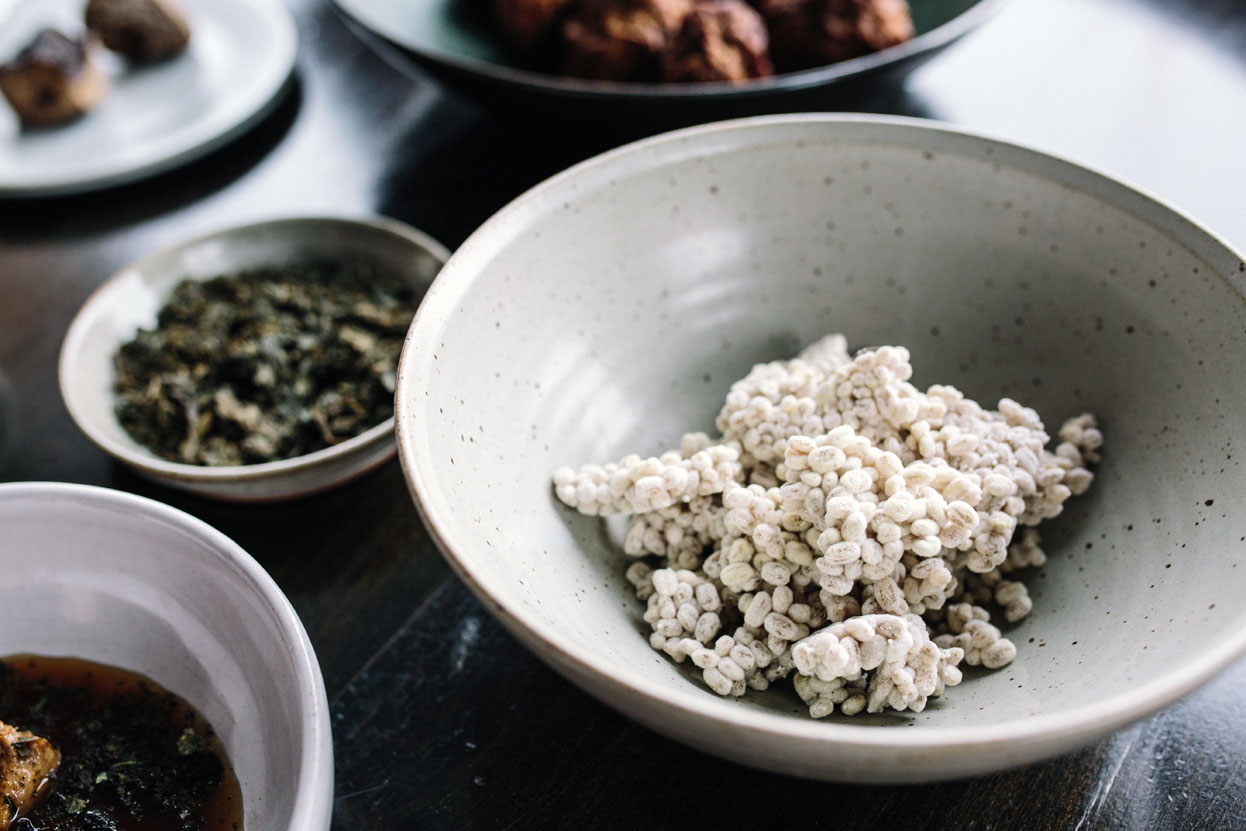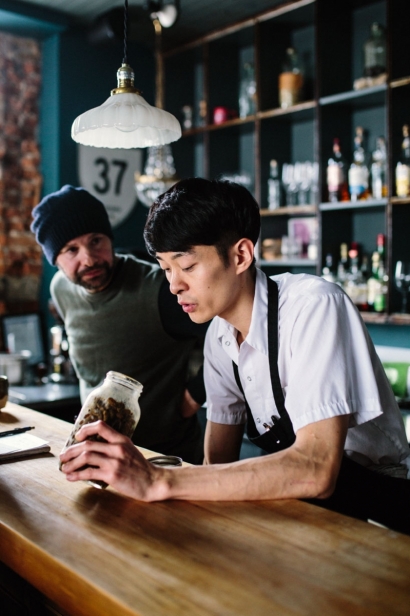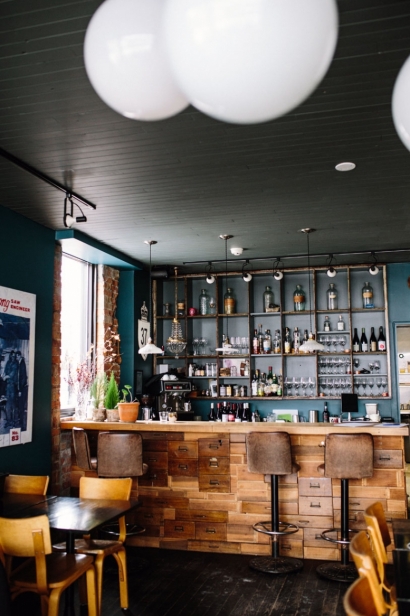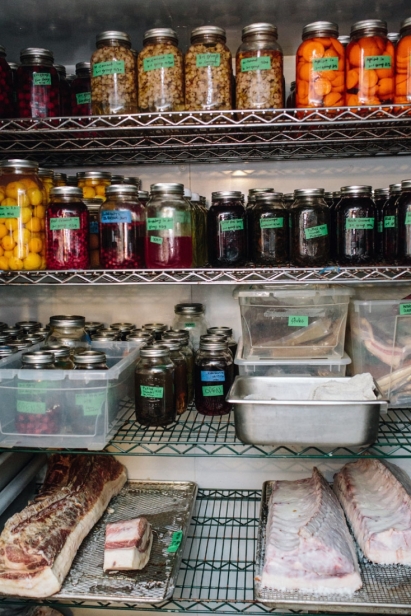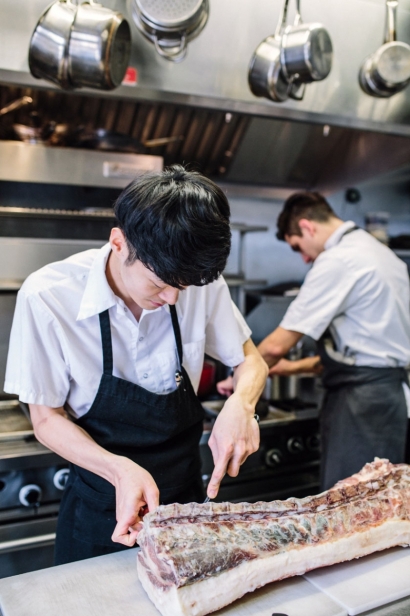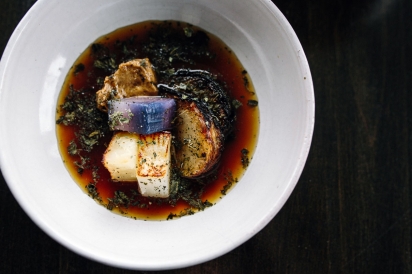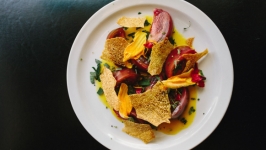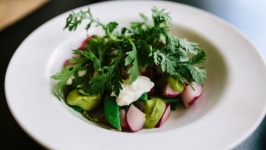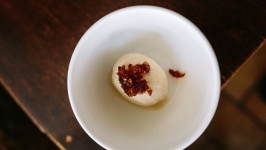The Koji Project
A seasonal and regional approach to Canadian cuisine forms the bedrock at Actinolite, the Ossington Avenue restaurant Justin Cournoyer opened in 2012 and named for the central-eastern Ontario town where he grew up.
Despite Cournoyer's staunchly local outlook, three years ago it hit him — something was missing — and he needed to look across the ocean to another continent for the answer: miso.
Cournoyer imagined the salty, earthy, profound umami flavours from fermented foods would add depth to vegetables, especially during late fall, winter and early spring, when there are few fresh varieties available from the local sources upon which he insists.
He was even craving umami in his own diet.
He was drawn to the idea of soy sauce on perfectly steamed early spring spinach or cured pickles made by immersing Canadian sunchokes in a creamy miso bath. He also craved salty-pungent kimchi made from fermented winter cabbage.
“We’re not inventing this stuff [or doing it] just because it’s new in the restaurant scene or popular as we’re learning from different cultures. This is an everyday [experience] and what we do is apply old techniques, but they support regional food,” Cournoyer says.
It started when Cournoyer was pondering how to add flavour to beets one evening. He turned to former Actinolite staff cook, John Greenwell, who now acts as a consultant and culinary researcher for the restaurant and said: “We have to make miso.”
Greenwell, who delights in flavour sleuthing and digging into the science of food, started researching koji as soon as Cournoyer mentioned miso. Koji, the Japanese word for the fungus Aspergillus oryzae, is used to break down foods to make fermented products — everything from miso to sake. Although, Greenwell is quick to point out, however, that fermentation, which means decomposition of sugar into ethanol, is a misnomer to describe these foods. The process is “enzymatic digestion,” but we’ll call it fermentation anyway.
Fermentation became one of the restaurant’s “pillars” two years ago during the 18-month period when Cournoyer closed Actinolite each Tuesday to brainstorm and work with staff on ideas. Out of that came “the koji project.”
“We balance each other,” Cournoyer says of how he and Greenwell work together. “He’s science and I don’t know science very well.”
What seems even more important to Cournoyer is their likemindedness about the philosophy behind Actinolite.
Greenwell is at the restaurant regularly, tending to and expanding the repertoire of foodstuffs fermenting in various ways in Actinolite’s cache of small basement walk-ins and storage rooms. The slightly funky-smelling area is combination flavour nursery and science lab, the results carefully monitored for health and safety. Greenwell tracks the progress using his Google account, with recipes and links to articles on things like surface mould.
“The food we do here is driven by our land and our farmers, the way we used to preserve a long time ago and taking all the cultural influence that is around our community and in the kitchen itself,” Cournoyer says.
Among those cultural influences are Actinolite’s chefs, including South Korean-born Kwangtaek Lee. He’s deeply involved with cultivating the koji and other fermentation projects at the restaurant.
Fermentation is behind the bold, flavour-rich sauces and condiments seen throughout Asian cooking, but it was also popular in ancient Rome to make umami-rich garum (think fish sauce), where fish and fish guts were salted and left to ferment in barrels.
Koji is often grown on soybeans or rice in Japan. At Actinolite, where the focus is on Canadian farmers and produce, it meant finding other carbohydrate and protein-rich growing mediums for the fungus.
Greenwell turned to Canadian barley.
Steamed just until cooked, the barley is dusted with a strain of mould Greenwell has been nurturing and growing for three years since starting with a small batch of starter mould from the Ontario Spring Water Sake Company in the Distillery District.
The fungus is grown on sheet pans in temperature-controlled units in the basement pantries and storage areas beneath the restaurant’s dining room.
The koji spores have been used to create a staggering number of products, each one crafted for a specific dish at Actinolite. There are more than 100 fermented items in the restaurant’s pantry used in the always-changing seven-course chef’s menu and smaller summary menu.
For the first miso, which is three years old and still used regularly in dishes at Actinolite, they decided against using soybeans as the primary ingredient because of the high percentage of genetically modified soy grown in Canada.
Greenwell researched the nutritional profile of a variety of Canadian beans and pulses and they eventually came across field peas. The local farmers said they usually feed it to cows, “but you can have them for a song,” Greenwell says.
That original batch of field pea miso now sits in a plastic bucket next to other varieties, each one covered with a weighted plastic wrap film across the top to prevent contamination.
Greenwell’s basement fermentation tour starts at a small wine cellar, in which a jug of cherry vinegar is aging next to a bottle of barley sake that smells like fine sherry.
Past the washrooms and into the rear storage area, a walkin cooler holds shelves with juniper, raspberry, pear and cider vinegars, jars of brightly coloured pickles and plastic tubs with bags of salted blossoms and fruits, all marked by contents and date.
Inside a small humidity- and temperature-controlled fridge, some of the 27 cured salamis made at Actinolite are being finished. They’re made with foraged native spices, including wild carrot seeds and crushed dried spicebush, which has a scent Greenwell describes as “citronella candle mixed with allspice.”
The exteriors of the hanging pork sausages made from a recently butchered pig are dusted with white koji powder. The fungus creates a creamy texture, much like Italian spreadable ’nduja.
Koji is also used to tenderize meats and in making seasonings. It shows up somewhere in something in just about every dish on the menu.
As for miso, you can make it from “darn near anything,” Greenwell says with pride. The chickpea with buckwheat and sunflower seed miso smells meaty and caramel-rich.
“We’ve done pumpkin, wild rose and peanut miso and potato with buckwheat miso for a crab dish with apricot juice to flavour with a miso butter sauce,” Cournoyer says.
Some misos are made quickly from meat scraps or fish trimmings and left to ferment in buckets in the furnace room, where the temperature is tropical warm.
“These are high-salt, meat-based ferments where we try to break it down as quickly as possible,” Greenwell says. One bucket has garum made from meat trimmings. Another has black trumpet mushrooms and yellow split pea miso — a gluten-free option for diners. A third pail is fermenting squid-based fish sauce.
It begs the question, what about food safety? Greenwell says board of health inspectors are there for regular visits.
“They know what we’re doing and when they ask us questions, we have answers for them. We’re not like, ‘yeah, it’s fine.’”
In the cold walk-in, sunchokes are buried in a tub of miso for pickles. Instead of traditional Japanese plums, green strawberries are being fermented to make salty-sweet preserved umeboshi.
And then there’s their unique takes on Japanese katsuobushi, the method of repeatedly salting, air and sun-drying, smoking and fermenting skipjack tuna or bonito into a wood-like block that’s shaved on food.
Greenwell produces Actinolite’s vacuum-sealed katsuobushi from small chunks of beef heart and pork liver. There’s also a bowl of crinkly, whole celeriac katsuobushi.
All the products for katsuobushi are cooked first, then alternately smoked and dried for 30 days and inoculated with mould.
Upstairs in the 30-seat dining room, where a tray of winter vegetables is drying on a radiator in the pale, late-winter sun, Cournoyer says koji is “a pillar and present in unexpected ways” at Actinolite.
The best way to understand the concept is to taste the food.
Cournoyer and Lee serve two examples of the koji project, a winter vegetable “pot roast” of grilled purple daikon, roasted turnip, rutabaga and half moons of delicate grilled and roasted black radish served in an earthenware bowl.
Fragrant fermented wild mushroom and nettle tea is slowly poured over the vegetables, then sprinkled with fermented nettles and dried marjoram from the restaurant garden.
“To me it’s the colours of what’s around us, we are cooking like this to express the moment," Cournoyer says, nodding to the sparse winter cityscape outside the picture window front of the restaurant.
The generous lump of miso butter in the bowl can either be smeared on the vegetables or mixed in with the nettle tea, reconstituted from Greenwell’s take on Chinese roasted and fermented pu’er tea.
“I’m trying to rethink it all the time,” Cournoyer says of Actinolite’s menu. “Where do we go, where do we grow, why are we doing it?”
I tasted the miso on the vegetables, then mixed it with the tea. The deeply flavourful results let the local ingredients come through with a rich umami undertone.
Next, I sipped from a small bowl of soup made from one-year-old miso, the top dotted with clear drops of pungent horseradish oil, a satisfying, complex taste that warmed and fulfilled.
“What started out in March 2012 as a little neighbourhood spot with a traditional three-course menu has slowly but surely evolved,” Cournoyer says.
“To me food is a seed to a more sustainable way of life. You’ve got to be part of a community,” he says. “Canadian food is land, farm, culture. We’re a young open-minded country. Utilize that culture and the land and the farm of your region and that’s Canadian food to me.”
Actinolite
971 Ossington Ave., Toronto, Ont.
actinoliterestaurant.com | 416.962.8943


